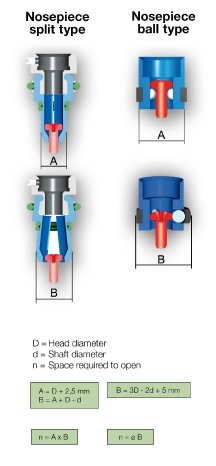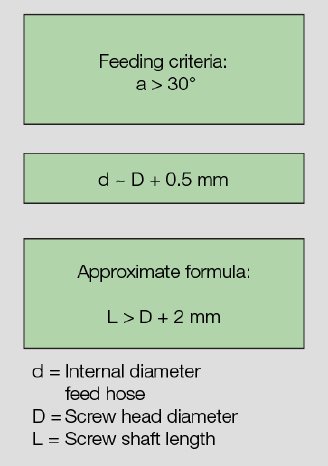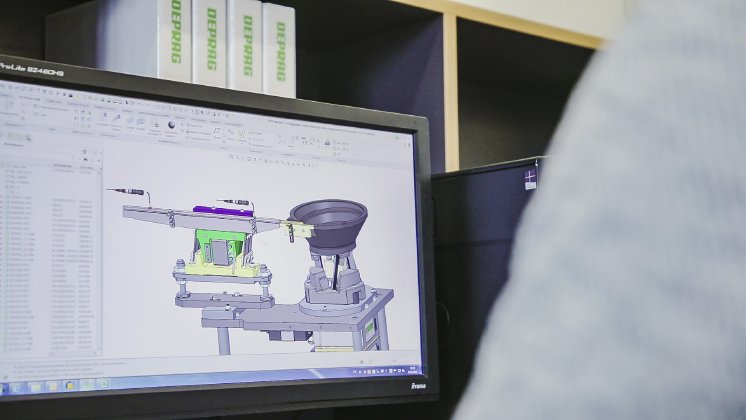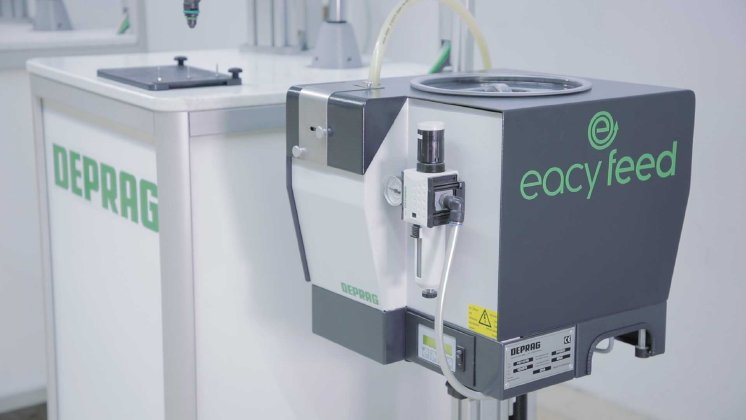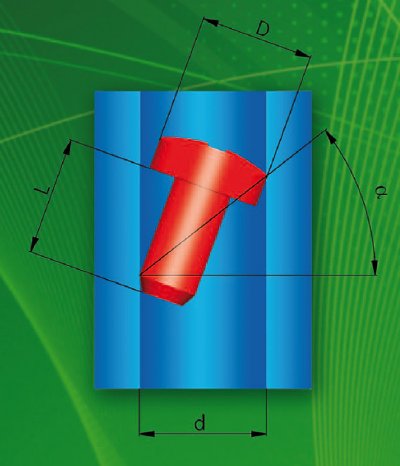Interviewer: Supply of fasteners, such as screws, via a feed hose is the preferred method of feeding, because it currently offers the best processing reliability and the shortest cycle times. Whether feeding via feed hose is actually possible, is decided by the experts at DEPRAG after a feedability analysis. How does such an analysis take all eventualities into consideration?
Lederer: The central question is whether automatic feeding of the screws via a feed hose is possible and if not, is it possible to make a simple change to the screw geometry to allow feeding via a feed hose? An approximation formula is one option used to test feedability via a feed hose (see image 1). This is the initial step in determining feedability. In the formula, the relation between the screw length to the screw head diameter is determined and from this, the probable angle of a fastener’s slanted position in the feed hose can be calculated. If the resultant angle is marginal, our specialists come into play. Using a dimension sheet of the screw, it is possible to determine the exact slanted angle of the screw in the feed hose using CAD software. Nevertheless, even with a negative result, feedability can often still be achieved through small changes to the screw geometry, such as the reduction of the head diameter or an increase in the screw shaft length. If making alterations to the dimensions of the screw is not an option, the Pick-and-Place procedure is the best choice. This feeding technology moves the fastener to a clearly defined position, allowing the screwdriving tool to target and pick up the fastener using vacuum, magnetism or a gripper device. Pick-and-Place feeding technology can also be used to supply other components, such as O-rings or labels.
Interviewer: Once the fastener has been fed using either a feed hose or the Pick-and-Place procedure, it must now be positioned over the assembly position. A screw fixture is used, such as a ball-type or split-type nosepiece. What are the specific criteria for choosing a fixture and what solutions are there for extreme cases, such as very deep lying screw positions?
Lederer: The decisive criteria for the selection of a screw fixture depends on the available space around the component. The split-type nosepiece requires space to open the jaws, whereas the ball-type requires a centering option around the screw position to ensure stable screw assembly. The type of screw fixture required is only determined after extensive analysis to guarantee the best processing reliability and ergonomic processing. If, for example, the screw position is particularly deep and the screw must be assembled in a recess, the risk is that the screw may fall into the hole and miss the core assembly hole. It may land at a slant and thereby block the entire process. The DEPRAG Feed Module is used to combat this so-called “free fall” problem. A screw fixture based on vacuum suction, suitable positioning stroke and a vacuum tube are used to ensure that the screw to be assembled is brought safely into position in the deep assembly location.
Interviewer: Speaking of positioning requirements – if necessary screw templates are used to aid positioning of the ball-type or split-type nosepieces. This, for example, prevents sliding on sloped housing contours and increases processing reliability. But does repeated re-positioning of the template affect the cycle time of the screwdriving process?
Lederer: Yes, of course alterations to the cycle time must be taken into account, as the screw template is placed down after each change of component and then removed again. A loss in time is, however only conditional, as each hole in the template has conical guiding chamfers which simplify positioning of the nosepiece. The positioning and removal of the template can, therefore be compensated as the number of screw positions increases, even shortening the total cycle time in some cases. The use of a screw template is precisely analysed in the preliminary stages, under consideration of all relevant aspects, and is only then implemented if it is decided that it has a positive effect on the application. Otherwise, template use is reserved for only those cases where use of the template is unavoidable. This, for example, applies to sensitive components in electronic production, such as are found in smart phones or vehicles, and aims to avoid component damage by the operator during screwdriver positioning.
Interviewer: For multi-feeding systems, there are various system layout options – the use of a distributor system, a twin device with double spiral or a combination of the two. What are the advantages of each of these variants and on what is the final decision dependent?
Lederer: The layout of the feeding systems is dependent on both the number of screwdriving systems which need to be supplied and the production rate. Single distributors can only separate out fasteners, they have no influence on the feeding sequence. Simply put, they can only be used to supply screwdriving stations which have the same requirements of screws per cycle time. Vibratory spiral bowl feeders with double spiral, also known as twin devices, can supply two screw positions completely independently from each other and thereby cover different requirements. The vibratory spiral feeder eacy feed from DEPRAG is available as a twin device. Furthermore, it offers additional advantages for the user: the eacy feed provides energy savings of 80 %. Eacy feed is Industry 4.0 capable. Using standardised, modular DEPRAG components, both multi-feeding concepts can even be combined, which means that we can respond to wide-ranging individual customer requirements. Our experts determine the ideal design for the requested application, taking the following into consideration: number of screws, cycle time requirements, a customer’s equipment needs and the economic factors. The number of outlets can be increased at will; however, this only makes sense up to a certain point for the application.
Interviewer: The quality of the screws to be fed is a relevant topic in terms of system reliability. Depending on the application, the required purity levels may vary. How do the experts at DEPRAG determine the recommended quality grade, in order to guarantee the most economic system whilst still retaining reliability?
Lederer: Screw quality in accordance with DIN standards is 3 %, therefore, in every 100 screws there may be 3 defective screws. This, however, is often not sufficient for reliability in feeding. There is not a universally valid value for all applications. Higher quality grades have a direct effect in improving system reliability. First, the optimal purity level must be calculated in consideration of the requirements for system reliability according to VDI 3423. These are determined from a technical and economic viewpoint, by our feeding technology specialists, considering the breakdown risks, in order to achieve an optimised, reliable end result for our customers.
